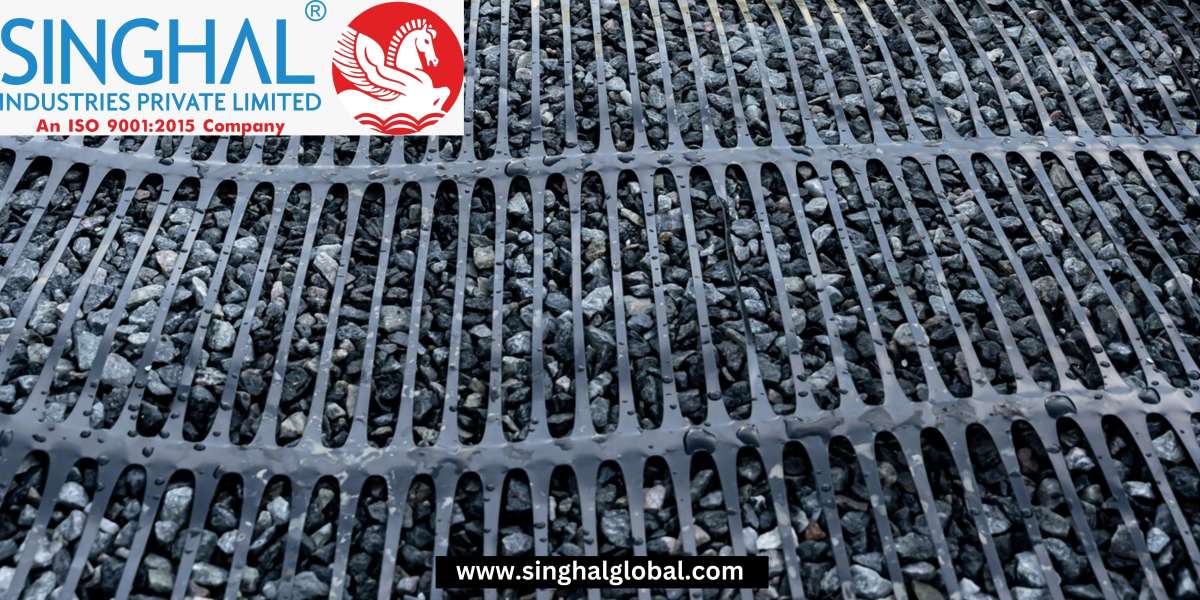In the world of civil engineering and construction, ensuring the stability and durability of structures is paramount. One key material that plays a vital role in achieving these goals is the uniaxial geogrid. Hdpe uniaxial geogrid are a type of geosynthetic material designed to reinforce soil, increase stability, and prevent erosion, making them an indispensable tool for a variety of applications, from road construction to embankments, and more.
This article explores the concept of uniaxial geogrids, focusing on their features, benefits, and applications. We will also examine the specific types of geogrids available, such as HDPE uniaxial geogrids, and highlight the growing demand for uniaxial geogrids in India, particularly for soil reinforcement. Whether you are a contractor, engineer, or involved in construction project management, understanding the functionality of uniaxial geogrids can significantly impact the quality and sustainability of your work.
What is a Uniaxial Geogrid?
A uniaxial geogrid is a type of geosynthetic material that is made from high-strength polymers. The material is designed with a series of longitudinal (parallel) ribs that help provide soil reinforcement. These geogrids are engineered to withstand heavy loads and are typically used for applications where soil needs to be reinforced to bear heavy traffic or structural loads.
Unlike biaxial geogrids, which have reinforcement in both directions (vertical and horizontal), uniaxial geogrids are reinforced in only one direction. This unidirectional strength is particularly beneficial in applications like slope stabilization, retaining walls, and embankments, where forces are primarily acting in a single direction.
Components of Uniaxial Geogrids
Uniaxial geogrids are typically made from materials such as high-density polyethylene (HDPE), polypropylene, or polyester. These materials are chosen for their strength, durability, and resistance to degradation caused by environmental factors such as UV radiation, temperature variations, and soil chemistry. The key components of a uniaxial geogrid include:
Longitudinal ribs: These are the primary reinforcements in the geogrid, providing strength and stability.
Junctions: The points where the ribs intersect or join. These junctions are crucial in ensuring the overall strength and functionality of the geogrid.
Openings: Geogrids have large openings between ribs, which allow the soil particles to interlock, enhancing the overall soil-reinforcing effect.
Features of Uniaxial Geogrids
Uniaxial geogrids come with a range of features that make them ideal for various reinforcement tasks:
High Tensile Strength: The material can withstand high loads and prevent deformation, especially when applied in high-stress areas like roads, embankments, and retaining walls.
Excellent Soil Interlock: The openings in the geogrid allow soil particles to weave into the grid, creating a stable composite structure. This interlock helps prevent soil erosion, increases soil shear strength, and provides long-lasting reinforcement.
Durability: Uniaxial geogrids made from HDPE or other durable polymers are highly resistant to environmental degradation. They can withstand harsh conditions, including exposure to UV rays, moisture, and chemical interactions with the soil.
Cost-Effective: Compared to traditional reinforcement materials like concrete or steel, uniaxial geogrids are often more affordable, making them an economically viable choice for soil reinforcement.
Easy Installation: The installation process for uniaxial geogrids is relatively straightforward, which helps reduce labor and construction time.
Applications of Uniaxial Geogrids
Uniaxial geogrids have diverse applications in civil engineering and construction. Below are some of the most common uses:
1. Soil Reinforcement for Roads and Pavements
One of the primary uses of uniaxial geogrids is soil reinforcement in road construction. By strengthening the soil beneath roads and pavements, uniaxial geogrids help distribute traffic loads more evenly, which reduces the likelihood of cracks and deformations. This reinforcement is particularly valuable in areas with weak or unstable soils.
Uniaxial geogrids for soil reinforcement help increase the bearing capacity of the soil and enhance the longevity of the roadway. They prevent rutting and potholes by stabilizing the subgrade, which can result in significant cost savings for road maintenance in the long run.
2. Slope and Embankment Stabilization
Uniaxial geogrids are widely used for stabilizing slopes and embankments, particularly in areas prone to erosion or landslides. By reinforcing the soil, these geogrids prevent soil movement and help ensure that the embankment remains intact under heavy pressure.
The grid’s strength and stability prevent shifting or settling, which is especially beneficial for constructing highways, railways, or large embankments that require strong foundations.
3. Retaining Walls
Uniaxial geogrids are commonly used in the construction of retaining walls to provide support and prevent soil displacement. Uniaxial Geogrid India are laid horizontally and secured to the wall structure, ensuring stability against external forces like water pressure, soil pressure, and seismic forces.
In retaining walls, uniaxial geogrids work by reinforcing the soil behind the wall, allowing it to bear more weight and resist movement. This is particularly useful in both residential and commercial projects that require retaining walls for landscaping, road construction, or drainage systems.
4. Landfills and Waste Management
Uniaxial geogrids are used in the construction of landfills to provide stability and prevent soil erosion. The reinforcement helps manage the pressure exerted by waste, preventing the collapse of the landfill structure. These geogrids are also used in landfill liners to reinforce the underlying soil layers.
5. Bridge Approaches and Foundation Stabilization
For bridge approaches and other infrastructure that requires firm foundations, uniaxial geogrids provide additional support and prevent shifting. They help stabilize the subgrade and ensure that the foundation can bear heavy loads, making them an essential material in bridge construction and rehabilitation.
HDPE Uniaxial Geogrid: A Key Component in Soil Reinforcement
HDPE uniaxial geogrids are one of the most common and reliable types of geogrids used for soil reinforcement applications. HDPE, or High-Density Polyethylene, is a highly durable material that provides excellent tensile strength and resistance to chemicals, UV degradation, and moisture. When used in uniaxial geogrids, HDPE ensures a long-lasting and cost-effective solution for various reinforcement projects.
The strength-to-weight ratio of HDPE uniaxial geogrids makes them a preferred choice for engineers who need to reinforce soil without adding excessive weight or bulk to the construction site. They are easy to install, require minimal maintenance, and provide long-term stability under heavy load conditions.
Uniaxial Geogrids in India
The demand for uniaxial geogrids in India has been growing steadily as the country undertakes large-scale infrastructure projects. With rapid urbanization and increased construction activity in the transportation and civil engineering sectors, there is a growing need for soil reinforcement technologies. The use of uniaxial geogrids is becoming increasingly popular in India for road construction, slope stabilization, and soil erosion prevention.
India’s government is investing heavily in road infrastructure, including the construction of national highways, urban roads, and railways. The application of uniaxial geogrids for soil reinforcement has proven to be effective in reinforcing weak soils and ensuring the longevity and durability of roads, embankments, and other infrastructure.
Choosing the Right Uniaxial Geogrid
When selecting the appropriate Uniaxial Geogrid for Soil Reinforcement for a project, several factors need to be considered:
Load-Bearing Capacity: Choose a geogrid with the necessary tensile strength and load-bearing capacity for the intended application.
Environmental Conditions: Consider the type of soil, weather conditions, and any potential exposure to chemicals or UV radiation when selecting materials.
Project Size and Budget: Geogrids vary in cost based on their materials and strength. Ensure that the chosen product is suitable for your project’s budget without compromising on quality.
Ease of Installation: Choose geogrids that are easy to install and require minimal labor, as this will help reduce construction time and costs.
Conclusion
Uniaxial geogrids are an essential component of modern civil engineering and construction, offering a reliable and cost-effective solution for soil reinforcement. Whether you are reinforcing roads, stabilizing embankments, or constructing retaining walls, uniaxial geogrids provide significant benefits in terms of strength, durability, and performance.
The use of HDPE uniaxial geogrids in soil reinforcement applications in India has seen a significant rise, driven by the demand for better infrastructure and the growing need for sustainable and cost-effective solutions. By choosing the right type of geogrid and understanding its properties, engineers and contractors can ensure the long-term stability of their projects and contribute to safer and more resilient infrastructure.
Frequently Asked Questions (FAQs)
1. What is the difference between uniaxial and biaxial geogrids?
Uniaxial geogrids are designed to reinforce soil in one direction (longitudinal), while biaxial geogrids provide reinforcement in both directions (longitudinal and transverse). Uniaxial geogrids are typically used in applications where soil reinforcement is needed in a single direction, such as road construction, whereas biaxial geogrids are used in applications requiring reinforcement in multiple directions.
2. How does a uniaxial geogrid improve soil stability?
A uniaxial geogrid improves soil stability by providing reinforcement through the interlocking of soil particles with the grid’s ribs. This interlock distributes loads more evenly, increases shear strength, and prevents soil erosion, enhancing the stability of the soil in areas subjected to heavy pressure or movement.
3. Can uniaxial geogrids be used in residential construction projects?
Yes, uniaxial geogrids can be used in residential construction projects, particularly for reinforcing foundations, stabilizing slopes, and constructing retaining walls. They provide cost-effective and long-lasting solutions for ensuring the stability of various soil types commonly found in residential areas.








